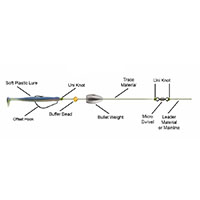Want to catch more bass? Then up your game and learn the most popular bass rigs that will help attract and hook greater numbers of trophy bass. Of all the bass rigs, the Texas rig is without question the go-to rig for serious bass anglers. It’s versatile and can be used in combination with a lot of fishing techniques and styles. The drop shot rig, while not as popular as the Texas or Carolina rigs, is another bass rig that has proven again and again to get the job done.
If you’re serious about become an expert angler, you should learn as many of the bass rigs as you can. While all bass rigs are designed to catch bass, each rig has a different purpose. Some rigs are weedless, so they can be fished near cover without getting snagged. Other rigs are designed for presentation. They present the lure in such a way to attract even the most finicky feeders. Even if you have a preferred go-to bass rig you prefer, knowing all the most popular bass rigs will ensure you’re prepared for every contingency.
The following are the most popular fishing rigs for catching largemouth, smallmouth and striper bass. While each rig is slightly different than the rest, learning how to make and fish each rig will ensure a successful catch even on the longest fishing days.

A weedless bass rig ideal for fishing in cover such as vegeration, rocks and weeds

Used for casting and dragging across a target area where fish may be located

Designed to minimize snaps and lose of fishing when fishing over rough ground

A bass fishing rig that can be fished deep, shallow, and anywhere in between

Ideal for fishing tough conditions. Small profile and mimics natural food source

A finesse fishing rig that mimics a bobbing and wiggling bait worm

A version of the wacky rig with a weight inserted into one end of of the soft plastic

A popular rig made of a straight-tailed worm rigged with a round jighead-style hook



